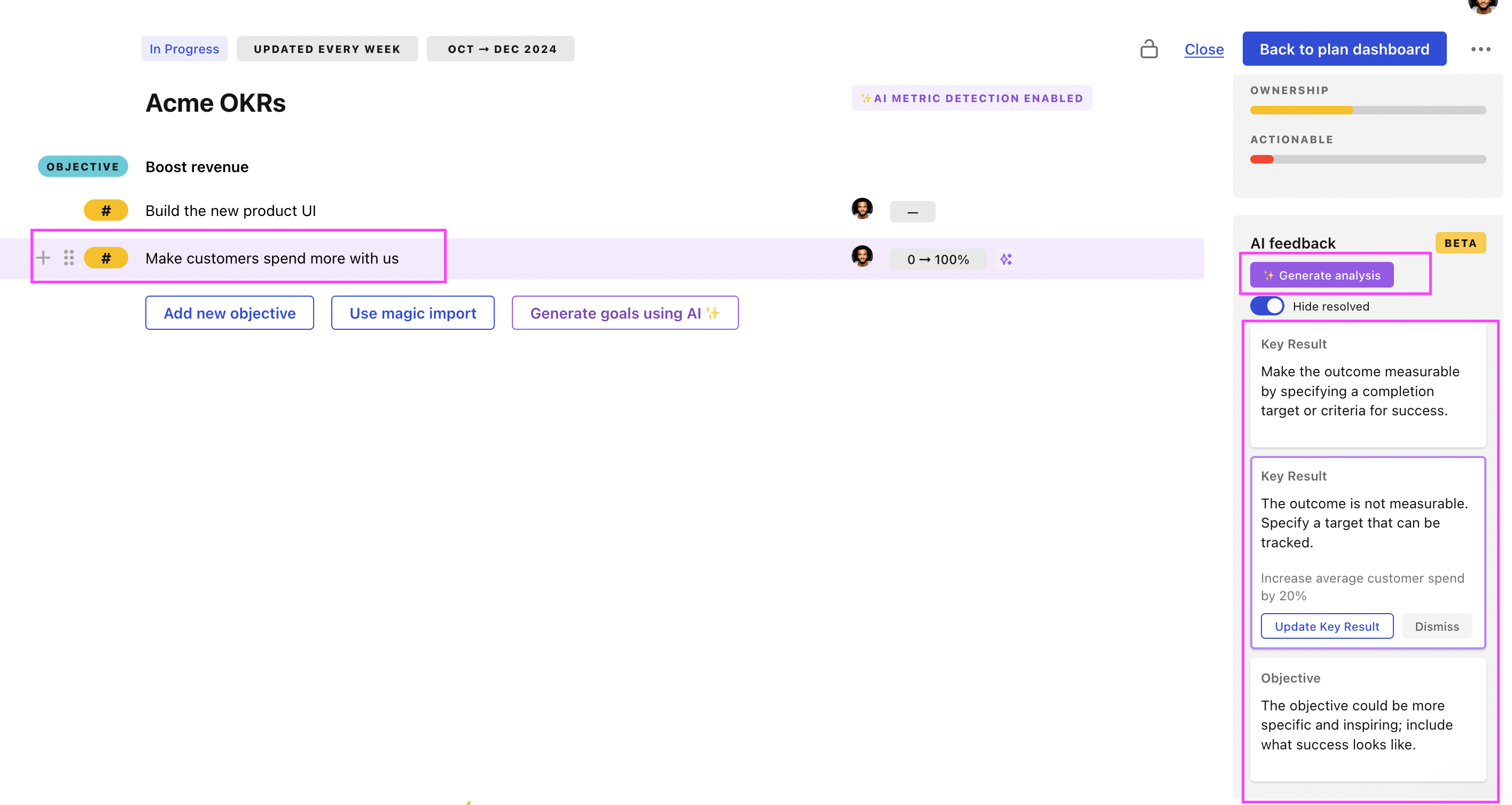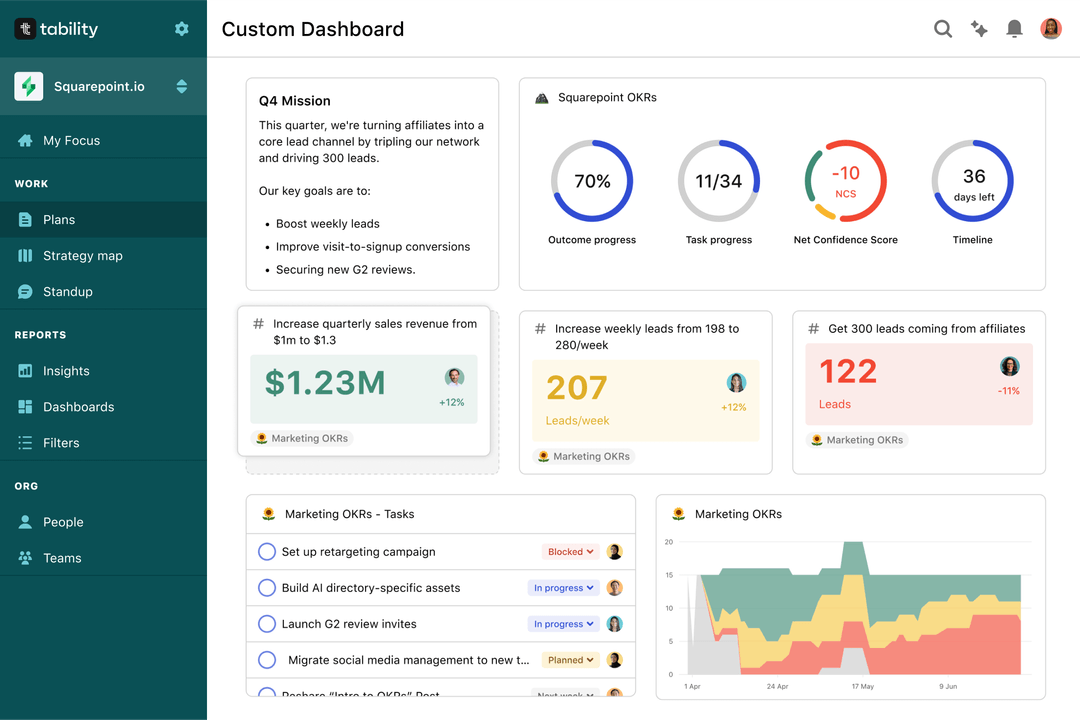Tability is a cheatcode for goal-driven teams. Set perfect OKRs with AI, stay focused on the work that matters.
What are Budget Compliance OKRs?
The OKR acronym stands for Objectives and Key Results. It's a goal-setting framework that was introduced at Intel by Andy Grove in the 70s, and it became popular after John Doerr introduced it to Google in the 90s. OKRs helps teams has a shared language to set ambitious goals and track progress towards them.
Formulating strong OKRs can be a complex endeavor, particularly for first-timers. Prioritizing outcomes over projects is crucial when developing your plans.
We've tailored a list of OKRs examples for Budget Compliance to help you. You can look at any of the templates below to get some inspiration for your own goals.
If you want to learn more about the framework, you can read our OKR guide online.
The best tools for writing perfect Budget Compliance OKRs
Here are 2 tools that can help you draft your OKRs in no time.
Tability AI: to generate OKRs based on a prompt
Tability AI allows you to describe your goals in a prompt, and generate a fully editable OKR template in seconds.
- 1. Create a Tability account
- 2. Click on the Generate goals using AI
- 3. Describe your goals in a prompt
- 4. Get your fully editable OKR template
- 5. Publish to start tracking progress and get automated OKR dashboards
Watch the video below to see it in action 👇
Tability Feedback: to improve existing OKRs
You can use Tability's AI feedback to improve your OKRs if you already have existing goals.
- 1. Create your Tability account
- 2. Add your existing OKRs (you can import them from a spreadsheet)
- 3. Click on Generate analysis
- 4. Review the suggestions and decide to accept or dismiss them
- 5. Publish to start tracking progress and get automated OKR dashboards

Tability will scan your OKRs and offer different suggestions to improve them. This can range from a small rewrite of a statement to make it clearer to a complete rewrite of the entire OKR.
Budget Compliance OKRs examples
We've added many examples of Budget Compliance Objectives and Key Results, but we did not stop there. Understanding the difference between OKRs and projects is important, so we also added examples of strategic initiatives that relate to the OKRs.
Hope you'll find this helpful!
OKRs to achieve regulatory compliance and manage change within budget
ObjectiveAchieve regulatory compliance and manage change within budget
KRIdentify and address 100% of current non-compliance issues
Develop plan to correct identified non-compliance issues
Review all current procedures and regulations for compliance discrepancies
Implement revised procedures and monitor adherence
KRImplement necessary changes within 10% under projected cost
Implement project management techniques to streamline operations and reduce costs
Negotiate with vendors for cost reductions or alternative budget-friendly options
Review current budget and identify areas for potential cost savings
KRComplete change implementation, ensuring 0% non-adherence to key regulations
Conduct periodic internal audits for assurance
Develop comprehensive tracking system for regulatory compliance
Educate all staff on updated rules and regulations
OKRs to implement regulatory compliance changes effectively
ObjectiveImplement regulatory compliance changes effectively
KRComplete implementation of all required changes on time
Monitor progress regularly, adjust plan as needed
Prioritize necessary changes based on importance and difficulty
Develop a detailed, daily work schedule
KRStay within 10% below the allocated budget
Maintain regular communication regarding spending with your team
Implement cost-saving measures where feasible
Review all expenditures weekly to monitor cash flow
KRReduce non-compliance incidents by 50%
Implement comprehensive compliance training for all staff members
Proactively monitor and audit compliance activities
Regularly review and update compliance policies
OKRs to successfully complete home renovation
ObjectiveSuccessfully complete home renovation
KREnsure 100% compliance with local building regulations and safety standards
Maintain up-to-date knowledge of local building regulations
Provide training for all staff on safety standards
Conduct routine safety and compliance audits
KRFinalize design plans by collaborating with architects within two weeks
Ensure finalized design plans within two weeks
Finalize design elements based on architects' input
Arrange a meeting with architects to discuss design plans
KRAchieve no less than 95% adherence to set budget for materials and labor
Implement stringent approval process for budget deviations
Conduct regular checks to ensure budget compliance
Prioritize essential materials and tasks to minimize overspending
OKRs to implement regulatory changes efficiently and economically
ObjectiveImplement regulatory changes efficiently and economically
KRForm a dedicated team to manage and expedite the changes by end of week 2
Identify individuals with the needed skills and availability
Assign roles based on competencies and workload
Establish a clear timeline and objectives for the team
KRDesign and release a detailed projected estimate of costs within week 4
Release the projected cost estimate by week 4
Design a detailed cost estimate
Collect all necessary data for projection creation
KRSuccessfully complete regulatory adjustment without surpassing the allocated budget and time
Analyze regulatory changes for potential financial impacts
Develop a comprehensive, budget-friendly adjustment plan
Monitor adherence to plan and deadlines
Budget Compliance OKR best practices
Generally speaking, your objectives should be ambitious yet achievable, and your key results should be measurable and time-bound (using the SMART framework can be helpful). It is also recommended to list strategic initiatives under your key results, as it'll help you avoid the common mistake of listing projects in your KRs.
Here are a couple of best practices extracted from our OKR implementation guide 👇
Tip #1: Limit the number of key results
Having too many OKRs is the #1 mistake that teams make when adopting the framework. The problem with tracking too many competing goals is that it will be hard for your team to know what really matters.
We recommend having 3-4 objectives, and 3-4 key results per objective. A platform like Tability can run audits on your data to help you identify the plans that have too many goals.
Tip #2: Commit to weekly OKR check-ins
Setting good goals can be challenging, but without regular check-ins, your team will struggle to make progress. We recommend that you track your OKRs weekly to get the full benefits from the framework.
Being able to see trends for your key results will also keep yourself honest.
Tip #3: No more than 2 yellow statuses in a row
Yes, this is another tip for goal-tracking instead of goal-setting (but you'll get plenty of OKR examples above). But, once you have your goals defined, it will be your ability to keep the right sense of urgency that will make the difference.
As a rule of thumb, it's best to avoid having more than 2 yellow/at risk statuses in a row.
Make a call on the 3rd update. You should be either back on track, or off track. This sounds harsh but it's the best way to signal risks early enough to fix things.
Save hours with automated Budget Compliance OKR dashboards

OKRs without regular progress updates are just KPIs. You'll need to update progress on your OKRs every week to get the full benefits from the framework. Reviewing progress periodically has several advantages:
- It brings the goals back to the top of the mind
- It will highlight poorly set OKRs
- It will surface execution risks
- It improves transparency and accountability
Spreadsheets are enough to get started. Then, once you need to scale you can use Tability to save time with automated OKR dashboards, data connectors, and actionable insights.
How to get Tability dashboards:
- 1. Create a Tability account
- 2. Use the importers to add your OKRs (works with any spreadsheet or doc)
- 3. Publish your OKR plan
That's it! Tability will instantly get access to 10+ dashboards to monitor progress, visualise trends, and identify risks early.
More Budget Compliance OKR templates
We have more templates to help you draft your team goals and OKRs.
OKRs to enhance auditing of homeowner communication and calls
OKRs to successfully complete annual security training
OKRs to acquire GCP certification with strong knowledge and skills
OKRs to improve internal stakeholder usability of new ERP system
OKRs to become Brazil's top professional development company
OKRs to increase Help Desk Quality Assurance Rating